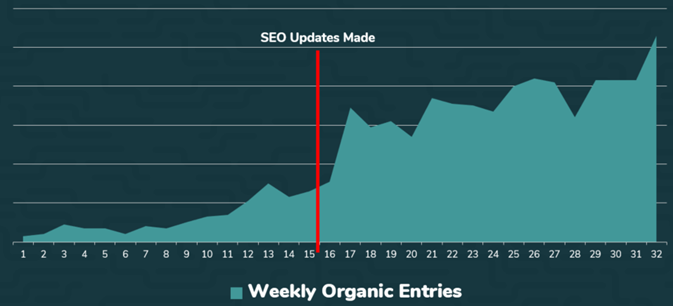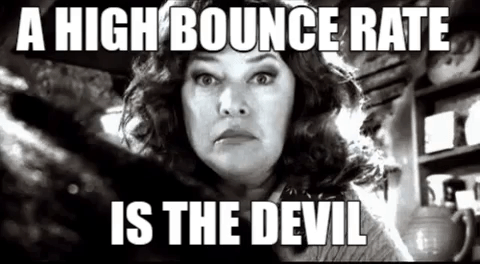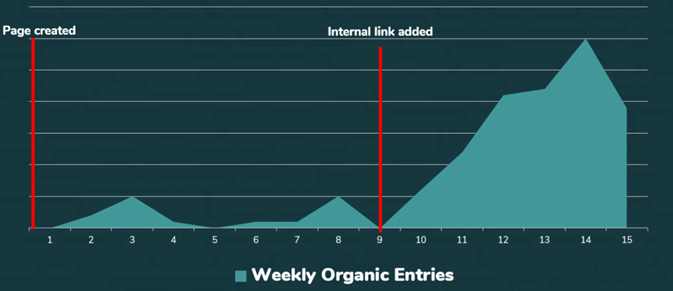SEO can boost your marketing automation efforts in these three ways:
- Build leads and lists through qualified organic traffic
- Utilize existing organic data to optimize conversion points
- Use keyword research to send targeted content to specific lists
Click on the links above to jump to that section.
I recently discussed this topic at the And Then Some emfluence Conference 2018. Here is the video and SlideShare of my talk:
But if you’re more into reading/scanning, the meat of the talk is below.
1. Build leads and lists through qualified organic traffic
Organic search and marketing automation are the perfect duo. Optimizing your site for search engines helps attract potential leads to your site, then your marketing automation efforts captures, profiles, nurtures, and converts those leads.
You want to structure your site and content in a way that drives leads to announce themselves and follow that with a great nurturing experience.
What is SEO?
Search engine optimization (SEO) is the practice of driving more qualified traffic to your site by optimizing visibility in organic search engine results.
How do you optimize your site for organic search?
How to optimize your site for organic search is a topic we could spend all day on and just scratch the surface. I’ll just give you a real quick hit on a bunch of SEO tactics here.
Maybe you work with an SEO agency or have an SEO person on staff and this will help you further understand, dive deeper, and collaborate with them. Or maybe this will spark an interest of something you know would impact your site today and this will drive you in the right direction to do additional research on your own!
We’ll break up the SEO tactics into 3 parts:
- On-page SEO
- Off-page SEO
- Technical SEO
On-page SEO tactics
On-page SEO is the practice of optimizing elements that live in individual pages’ source code to rank higher and earn more relevant organic traffic.
The goal with on-page SEO is to help crawlers understand the meaning and context of your pages by speaking the search engine’s language.
Here are some on-page SEO elements:
Content
There is a lot in the content strategy of SEO, but in short, find your targeted keywords, think of the users intent of searching that keyword, and build content to satisfy that intent.
And not only the copy of the content, but how that content is structured. One of the more successful content structures we’ve seen lately has come from the classic journalism inverted pyramid – learn more here and here.
Think about your user’s intent upon entering your page. Satisfy that intent instantly. Then go on to add supporting details and related topics. As opposed to a popular blog content structure we see often – question, fluff, fluff, fluff, answer, the end.
Metadata: Page title and meta description
There are a ton of different meta tags, but in this case, I’m talking about your page title and meta description. This is the what you see in Google’s search results pages; the big blue title and the little black description. Your metadata tells Google what you recommend they show there. Although, Google can choose to change it if they see fit.
Your page title should briefly tell search engines and users the main purpose of the page while including targeted keywords as the page title can impact rankings.
Your meta description, while it doesn’t really impact rankings directly, it can impact the click-through rate from the search results page. You want to write a description that tells users what to expect from the page, including targeted keywords that will be bolded upon a matching or related search, and the description should leave them wanting a little more, aka a click.
URL
Your URL, like your page title, should include targeted keywords separated by hyphens, that will tell users and search engines what they can expect to find on the page.
URLs should follow a consistent format, non-www vs www and trailing slash vs non-trailing slash whatever you are, be consistent, and use lowercase letters and HTTPS.
Your URLs should follow a categorical hierarchy. We’ll briefly touch on site structure in the technical SEO section, but in short, if your website has a section about beers, your URL structure should be something like /beer/pale-ales and /beer/stouts
Image alt text
Your images should have alt tags, or alternative text.
Since search engines can’t see what’s on an image, you use alt text to describe the image to search engines. You can also use image titles to provide additional context about your image to search engines.
Alt text also helps you remain ADA compliant, the Americans with Disabilities Act. For any user with visual disabilities, or really any user that uses a screen reader, the screen reader will read the provided alt text to describe the image to the user.
Heading tags
Heading tags are tags used to create headings and subheadings within your content. These follow a hierarchy of importance from H1-H6.
You should include one headline or H1, and use subheadings H2s and sub-subheadings H3, to break-up your content when necessary, including any relevant targeted keywords in the tags. For users and search engines, headings make the page easier to scan and discover the primary points of the page.
Internal linking
When you link from one page on your domain to another page on your domain, it helps users and crawlers navigate your site, helps spread ranking potential from one page to another, and helps establish an informational hierarchy. The anchor text of your links, or the copy that is wrapped in the link, should include relevant, targeted keywords so users and search engines get more context on the linked page.
Off-page SEO tactics
Off-Page SEO refers to all of the activities that you do away from your website to raise the ranking of a page within search engines.
Here are some off-page SEO tactics:
Link building
Backlinks, or when another website links to your website, are valuable for your ranking potential. In Google’s mind, those links count as a vote of approval for your page and domain.
There are a lot of tactics to develop for backlinks – learn more here and here.
Business listings
Make sure your business is listed in every relevant directory possible. This includes places like Google My Business – the information you often see about businesses in the panel to the right of search engines results pages, yelp, and any other relevant directory in your industry.
This is not only good to get your brand and business out there, but those directories provide more context to search engines and shows them you’re a legitimist business with a legitimist website.
Social media
Some people claim social media engagement metrics are a ranking factor. I say they are wrong. That’s just correlation, not causation. Quality content will perform well on social media. Quality content will rank highly in search engines. One doesn’t cause the other.
But social media is a great way to have more eyes on your content and brand, which can lead to more backlinks and high-value branded searches.
Guest posts
Guest posts, often used as a link building tactic, but has the additional benefits like social media – it’s a great way to have more eyes on your content and brand, which can lead to more backlinks and high-value branded searches.
Reach out to relevant industry blogs and see if you can submit a new post.
Forum participation
Go to relevant industry forums and relevant subreddits and authentically help answer questions. Don’t be ‘spammy’ or ‘market-y’. Forum users and mods can sniff that from a mile away.
Like guest posts, this is often used as a link building tactic, but Google puts less weight in forum links. Forum participation has benefits like social media – more eyes on your content and brand, leading to more backlinks and branded searches.
Search engine submissions
Make sure your website is validated in Google Search Console and Bing Webmaster Tools.
Search engines will crawl and find your internally linked content eventually, but you can submit new or updated pages here for them to crawl earlier. You can also submit your XML sitemaps and pull valuable organic keyword data.
Technical SEO tactics
Technical SEO refers to tactics used to aid in the crawling and understanding of your content for search engines, which is a little more behind-the-scenes than on-page SEO.
Here are some technical SEO tactics:
Site architecture / crawlability
Your site should be easily crawlable by using proper internal linking and context should easily be understood by following a category hierarchy.
We briefly touched on this is within on-page, but in short, if your website has a section about beers, your menu structure should be something like /beer/pale-ales and /beer/stouts, then wine could be /wine/red/cabernet.
As opposed to just having /samuel-adams-boston-lager right at the root domain level, or just /yellow-tail-cabernet. Search engines won’t receive the additional hierarchical context without the categorical subfolder structure.
If a page is created outside of the site’s menu structure and is never internally linked – known as an orphan page, it’s likely not going to be crawled or indexed, and if it is, it likely isn’t going to have much ranking potential.
Ensure your priority pages are linked within your main menu structure.
XML sitemap
An XML sitemap is a file that lists all of the URLs you want search engines to crawl. The XML Sitemap acts as a map for search engine crawlers.
I get this question a lot:
Are the pages listed in the XML sitemap the only pages Google will crawl?
No – while the XML sitemap is the best place to inform search engines about the existence of your content, they will follow the sitemap along with the internal linking structure of your site.
Robots.txt
While the XML sitemap is the map for search engines, the robots.txt file acts as a set of instructions.
The robots.txt file is where you can tell search engine crawlers where to not waste their limited time crawling your site.
Meta robots no index tag
<meta name=”robots” content=”noindex”>
While the robots.txt file is used to inform search engines where not to waste their time crawling, the meta robots no index tag informs Google to not index that particular page.
Use this tag if there is a page you know you don’t want Google to index, like a thank you page containing an ebook download – you want people to fill out a form first. Keep in mind you want Google to crawl this page to see the tag, so do not disallow a page in the robots.txt file that contains the tag.
301 redirects
301 redirects help ensure as much of the old location’s previous ranking potential as possible is passed to the new location.
If a page is removed from your site, 301 redirect that old location to the most relevant, live location.
If there is duplicate content on your site, 301 redirect the duplicate pages to the one page you want to rank organically.
Like we briefly discussed under URLs, 301 redirect all other URL formats to your primary format, non-www vs www and trailing slash vs non-trailing, lowercase letters, and HTTPS.
Canonical tags
A canonical tag is a way of telling search engines that a specific URL represents the true, primary owner of the content.
301 redirects are more important than canonical tags, so if you have duplicate content, 301 redirect it to one location.
But if there is ever a reason that the same content should live at two locations, ensure there is a canonical tag on each page pointing to your primary location. That way you are not diluting your ranking potential among multiple locations.
Status codes
Status codes inform search engines of the status of the page.
200, it’s OK, it’s live. 301, it has been permanently moved to this new location. 404, does not exist.
I’ve noticed it’s more and more common to have a custom 404 message when content does not exist at the location they are trying to access – yay, that’s best practice. But I’ve noticed a lot of the time, that custom message serves a 200 status. These sites are essentially saying, “Hey Google, this page (that doesn’t truly exist) is live, you should index it, along with these infinite other URLs that serve the same message.”
Replace broken resources
Ensure all your internal links and images reference live resources.
Being led to a non-existent location is a bad experience for both the user and search engine crawler. This is commonly found on older blog posts that may still be generating organic traffic.
Schema markup
Schema is coding that provides additional context to your content for search engines.
This can result in higher rankings and receiving search results display benefits like images or product information appearing directly in the search results page.
Page speed
A faster page load time is a great user experience and a ranking factor – make your site as fast as possible.
Site security
A secure site is a great user experience and a ranking factor – make your site secure.
Mobile-friendliness
A mobile-friendly site is a great user experience and a ranking factor – make your site mobile-friendly.
Case study
We implemented many of the above tactics on a client’s blog post that was showing great potential.
Here are the organic entries to this page overly the last 32 weeks. I blinded the specific numbers, but you can see the trend line.

Weeks one through 15 it was just a blog post title, “How Big Is A Number 10 Envelope?” with a little fluff, the answer, and some more Tension-brand specific #10 envelope content.
This blog post showed a lot of potential since it ranked middle of page 1 for medium-search volume, clear intent keywords like, “how big is a number 10 envelope” and bottom of page 1 or top of page 2 for high-volume, less clear intent keywords like, “#10 envelopes”. We just made a few tweaks and additions and saw traffic skyrocket.
These tweaks included a lot of the above tactics:
- Directly answering the targeted question immediately below a subheading that asked the question
- Added more supplemental content to make it more of an ‘everything you need to know about #10 envelopes’ type of post
- This includes a what are #10 envelopes section and sections of their benefits, their windows and window dimensions, and how they can be customized.
- Most of which is unbranded content with a little bit of brand sprinkled in.
- Metadata updates
- Image alt and title tag additions
- Subheading keyword targeting
- Internal linking
- Linking from the post to other relevant pages of the domain
- Linking from other relevant pages on the domain to the post
What did this do for the client?
Because of those few changes, the client:
- Received more industry-specific traffic
- Produced more quality brand engagements
- Increased traffic to deeper pages within their site
Think what it could do for your business
- What pages on the cusp of good to great could use a quick makeover to further satisfy your user’s intent?
- Are there new pages you could create to answer questions your prospective customers may be searching?
- What can you do to drive leads to announce themselves?
2. Utilize existing organic data to optimize conversion points
You’re likely already sitting on a valuable pile of organic data. Utilize your organic traffic data to help generate more leads.
An example
See what pages on your site right now are generating a high number of organic visits, but have a high bounce rate. A bounce is when someone enters your page and then leaves without looking at another page.
Quick bounce rate side rant
I hear a lot of digital marketers sounding like the Waterboy’s mom right here.

A high bounce rate is NOT the devil. Here is an example.
Let’s say you are searching for a lasagna recipe. You click on one of the top 3 results. Hey, this lasagna looks good and seems easy enough. You write down the ingredients to your shopping list. Then you….BOUNCE. How evil of you! You are a terrible person, that website was terrible, that experience was terrible, that marketing team is terrible!
No! That was a good experience. Your need was met. You had a good experience with that brand. Now you may be more inclined to interact with that brand in the future.
Nothing was the devil in that situation. Rant over.
Back to the example
See what pages on your site are generating a high number of organic visits, but a high bounce rate.
Yeah, a high bounce rate is NOT the devil, but you can always try to improve it. And using these types of pages are a great starting point.
Often sites with a quality blog will have many of these pages. A potential lead is searching about a topic related to your industry, your blog post provides the best answer, you rank highly for their query, they click to your site, they find their answer, and the bounce.
It was a good user experience, they got the answer they needed. It was a good experience for your site, that user had a valuable experience with your brand.
That was good, but it could be great!
When visitors continuously bounce on a certain page
Find a way to:
- Naturally send that user to a high converting page through internal links
- Or create a new offer custom-built for that user type.
Naturally send users to a high converting page
If you have a page that converts 25% of its visitors and it’s relatively related to the high traffic, high bounce rate page – you should find a way to naturally send the user to that conversion page.
Let’s use that lasagna recipe example again.
You know if you can just get the user to a coupon page, they have a 25% chance of handing you their email address in exchange for a coupon. Just add copy links or a nice designed button near the ingredients list showcasing your coupon offering. More visits to your coupons page, more conversions.
Case study
For the client, we got a little creative on how to execute this strategy.
On that same blog post discussed earlier, after we made the SEO updates, we had a ton of traffic due to high rankings and answer box ownership, but most were bouncing after finding their answer.
We noticed the other pages competing in that space were sending their users to a specific-page type. The client didn’t have a page like that, so we created that page. Then we found a relevant way to internally link to it from the popular blog.

Not only did overall page views increase, but organic entries skyrocketed to this new page after adding the internal link from the authoritative blog post. Yay, more correlation for the SEO-value of internal links.
You should be looking at your popular organic entry pages and see if there are any relevant, priority pages you can boost with an internal link.
Create a new offer custom-built for that audience
Instead of sending your users to a high converting page, you can create a new, custom offer, built just for that user in mind.
For the client, we all sat down and asked each other, “When visiting this top organic entry page” –
- What are these people looking for?
- What do we want these people to do?
- What could we offer that would be enticing to them?
Case study
We noticed that most of the traffic coming to the previously mentioned #10 envelope blog were coming from searches like, “how big is a #10 envelope”. This post not only has a lot of bounces, but a lot of return visitors as well.
- What are these people looking for?
- Envelope sizes
- What do we want these people to do?
- Give their email address
- What could we offer that would be enticing to them?
- An envelope size cheat sheet to keep at their desk
The client is currently working on this. I’ll update this post accordingly once we have the data.
What about your top organic entry pages?
- What are your users looking for?
- What do you want these people to do?
- What could you offer that would be enticing to them?
3. Use keyword research to send targeted content to specific lists
Keyword research is not just for SEOs. You can use keyword research techniques to get a better understanding of your segmented lists’ interests, questions, and concerns. Then you can send them some targeted content.
Shout out to a friend and former colleague of mine, Tylor Hermanson, who inspired this section. At recent events, he discussed why reserving search data for search engine marketing alone is a giant, missed opportunity.
Some of this data comes from the book Everybody Lies by Seth Stephens Davidowitz. I highly recommend it if you haven’t read it. It’s basically about how we all lie, or at-least don’t tell the full story in our everyday lives. This book attempts to find some truths by using big data, including Google search data.
There are many great anecdotes in the book, but I believe these 2 – which Tylor pulled into his talk – summarize everything the best.
Everybody Lies
Survey data
Seth analyzed data from the General Social Survey, which is considered one of the most authoritative sources of information on Americans’ behaviors.
According to the survey, heterosexual men over the age of 18 in the US claim to have sex 63 times a year and use a condom 23% of the time. With 121 million heterosexual men above the age of 18 in the US, that comes to 1.7bil condoms.
Heterosexual women over the age of 18 in the US claim to have sex 55 times a year and use a condom 16% of the time. With 128 million heterosexual women over 18 in the US, that comes to 1.1bil condoms.
So who’s lying?
Everyone, by a lot!
Nielsen, who tracks consumer behavior, reported 600mil condoms are sold every year. And that is just condoms sold in general, any sexual orientation, any tasteful bachelorette party gift, and so on.
What does Google say?
Seth then dives into Google searches, which showed a less lively, but possibly a more accurate picture of sex.
The top complaint about marriage according to Google searches is not having sex. “Sexless marriage” searches were 3 and a half times more likely than “unhappy marriage.”
Even unmarried couples – sexless relationship searches were second only to abusive relationship searches.
So, we know we must take survey data with a grain of salt.
Social media data
Seth brings up The Atlantic vs The National Enquirer.
They report similar sales numbers (The National Enquirer actually sells more since it’s weekly, but taking into account frequency of releases, it evens out) and they receive a similar number of Google searches.
But the Atlantic has 27 times more Facebook likes.
Are we trying to paint ourselves in a better light by claiming we read The Atlantic or do we not want to broadcast the fact we read The National Enquirer?
Incentive
What’s the incentive for you to be completely truthful on surveys or your social platforms?
I can relate. Who knows this dreaded question you receive on your annual physical?

Well, I have a drink containing alcohol 3 or 4 days a week. Friday, Saturday, and maybe a weekday or two. But, on Friday and Saturday, I tend to not just have one…
Do I paint myself in a good light by selecting 3 or 4, or do I select the more accurate than not 8 or more.
What’s my incentive to lie? I don’t want to be judged or looked down upon by my doctor.
What’s my incentive to tell the truth? I potentially receive a more accurate diagnosis.
We care about how we are perceived by others. People instinctually want to showcase the good in their lives and downplay the negatives.
What’s your incentive to lie to Google?
What about with Google? What is your incentive to lie there? The more honest you are, the more likely it is that you will get what you want.
This is what makes search data one of the most realistic data sets we all have access to review.
The case for search data
Seth was able to correctly predict the 2016 election results, a few weeks before election day, with search data – beating the incorrect insights gathered from most polls.
He didn’t use searches for “Trump” or for “Clinton”, as those searches don’t really give intent. You could be a Hillary supporter just searching about Trump. But when searches include both candidates, that shows more intent. The candidate listed first is more likely the favored candidate.
“Clinton vs Trump” is more likely searched by a Clinton supporter. “Trump Clinton debate” is more likely searched by a Trump supporter.
Over the previous 2 elections, this showed a strong correlation with the election results and Seth used this model to correctly predict the results right before the 2016 elections.
Moral of the story
- Don’t take all data at face value
- Confirmation bias is at play. The data may have been pulled to confirm a predetermined theory.
- Incentive – the people behind the data you are studying may not have had the incentive to tell the whole truth.
- Search behavior data is not just for SEOs
- You can use search behavior as another way to uncover insights about your audience.
Uncover insights about your audience to send them highly relevant content
Use search behavior as another way to uncover insights about your audience. Here is a great example of a marketing automation campaign that really knew their audience and how keyword research likely played a role.
My wife and I got married on March 31st and left for our honeymoon the next day.
We booked a trip to Paris and London through one of those travel booking sites that includes everything – airfare, hotels, city-to-city train, and cabs to the airport. This was our first time planning a trip of this magnitude – overseas flight, foreign country, plus the chaos of leaving right after a wedding you’ve been planning.
The booking platform’s automated email series anticipated all our concerns and eased our worries before this big trip!
The travel booking automated email series
- Confirmation
- Right after ordering the trip, I received a confirmation that everything was in the process of being booked.
- Perfect, I have nothing else to worry about.
- Itinerary and confirmation numbers
- The next day I received an email with all the confirmation numbers and an itinerary of all the flight times, hotel addresses, durations, and more.
- Awesome! Everything I needed to know, delivered to me all in one place.
- Documentation and passport info
- A few days later I received an email informing me of all the documentation I need to get over there – make sure you have a valid passport, here is how you get one, and this is how long the process typically takes.
- Great, thanks, vacation package company!
- Recommended ideas
- A little more time passes, then I receive and email with a blog, ‘The Best Things to Do in Paris and London in the Spring’.
- Hey, I’ll be there in the spring! Awesome! While I was already planning on looking this up, now I don’t have to put in the effort.
- Travel tips
- Then a week or so before the trip I receive and email with a blog titled, “Tips for Getting Through a Long Flight”
- Whoa! I didn’t even think about that! This will be my first overseas flight to Europe. What are some tips for getting through this long flight? It told me all about how to avoid jet lag, don’t forget to stand up at some point, noise-cancelling headphones, and more.
What blew my mind?
- They anticipated my needs
- Through look-alike modeling – ‘hey, these people are just like you and are interested in this, you probably will be to’ – they were able to send me content I found valuable.
- Valuable brand experience
This was such a valuable brand experience. I fully plan on using this service again because they blew me away – even though there was a 4am issue with our airport taxi confirmation number on the final day that caused some drama at the end of the exhausting trip.
Keyword research techniques
Here are some keyword research techniques and free tools you can use to uncover valuable content ideas for your emails.
Google Correlate
A cool, free tool available is Google Correlate.
When you type a search query in Google Correlate, it will show you other search terms that have a similar search pattern to the query you entered. The coolest thing about this tool, in my opinion, is you can offset it by weeks. This way you can essentially see if someone searched X, two weeks later they may have searched Y. Find more information on Google Correlate here.
So, I typed in “flight to London” and “flight to Paris” per the travel booking automated email series from earlier, and the results were pretty cool.
- After 1 week: Trip itinerary
- Trip itinerary searches correlated with ‘flight to [London/Paris]’ after 1 week, just like the email I received!
- After 2 weeks: Hiking pants
- Hiking pants searches correlated with “flight to Paris” after 2 weeks. There are a lot of great places to hike in that area. Let your audience know and anticipate their needs.
- After 3 weeks: Car rentals and Iceland
- Car rentals and traveling to Iceland searches correlated with ‘flight to [London/Paris]’ after 3 weeks. Maybe your audience hasn’t committed to London, but they’d also be interested in Iceland. Let them know about your Iceland offerings!
- After 4 weeks: NSFW
- NSFW searches correlated with “flight to Paris” after 4 weeks. If you’re playing along at home, type in flight to Paris, offset by 4 weeks, and you’ll see why it is a popular romantic honeymoon destination.
- After 6 weeks: Hotel bookings
- Hotel booking searches correlated with ‘flight to [London/Paris]’ after 6 weeks. Once you know it will be a romantic trip to Paris, time to book the hotel room!
While you will receive a lot of random, irrelevant queries that just happen to correlate, this is still a cool way to find what your audience may be interested in the future.
Answer the Public
Another awesome, free tool is Answer the Public.
When you type-in a term like, Paris, it produces a ton of great questions your audience may have, like “Where to eat in Paris” and “Are Paris and Kim still friends?”. It also provides popular preposition and comparison searches.
Bonus points if you pair this tool with the Chrome and Firefox addon, “Keywords Everywhere”. This plug in will show you the search volume, provided by Google Keyword Planner, for all the provided keywords.
Honorable mention – https://keywordtool.io/ also provides a lot of great keywords and questions based upon a search term you enter.
Keyworddit
Finally, Keyworddit.
You enter a subreddit forum and this tool extracts the popular keywords used in that subreddit.
I entered in the subreddit travel and was able to uncover that travel insurance, long flights and train rides, and passport issues are frequently discussed in this travel forum. Give your audience this information before they even think to searching for it!
Conclusion
How can you use SEO to boost your marketing automation efforts?
You can build leads and develop your lists through qualified organic traffic. Optimizing your site for search engines helps attract potential leads to your site. Your marketing automation efforts then nurtures those leads.
You can use your existing organic data to optimize your conversion points. Naturally send users from a high traffic entry page to a high converting page through internal links or create a new custom-built offer for that specific user type placed on the high entry page.
You can use keyword research to send targeted content to specific lists. Use keyword research to gain a better understanding of your segmented lists and send them highly targeted content.
Comment your thoughts/questions below or message me on Twitter at @evanyule.



